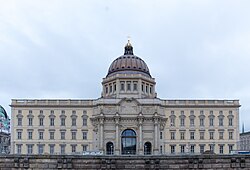
Albert von Le Coq was a Prussian/German brewery owner and wine merchant, who at the age of 40 began to study archaeology.
The Arbeitsrat für Kunst was a union of architects, painters, sculptors and art writers, who were based in Berlin from 1918 to 1921. It developed as a response to the Workers and Soldiers councils and was dedicated to bringing current developments and tendencies in architecture and art to a broader population.

The Museum of Cultures in Basel is a Swiss museum of ethnography with large and important collections of artifacts, especially from Europe, the South Pacific, Mesoamerica, Tibet, and Bali. It is a Swiss heritage site of national significance.

The Museum of Asian Art is a part of the Humboldt Forum in Berlin since 2020. Before its relocation it was sited in the neighborhood of the borough of Steglitz-Zehlendorf, Berlin, Germany. It is one of the Berlin State Museums institutions and is funded by the Prussian Cultural Heritage Foundation. It houses some 20,000 Asian artifacts, making it one of the largest museums of ancient Asian art in the world. The museum is located in the same building as the Ethnological Museum of Berlin. The museum houses important collections of Art houses of South, Southeast and Central Asian countries and art from the Indo-Asian cultural area, from the 4th millennium BC to the present. Its geographic reach covers regions in India, Pakistan, Afghanistan, Sri Lanka, Bangladesh, Nepal, the Autonomous Region of Tibet and Xinjiang of the People's Republic of China, the Southeast Asian countries of Myanmar, Thailand, Cambodia, Vietnam, and also the Indonesian Islands or archipelago.

The Staatliche Museen zu Berlin are a group of institutions in Berlin, Germany, comprising seventeen museums in five clusters; several research institutes; libraries; and supporting facilities. They are overseen by the Prussian Cultural Heritage Foundation and funded by the German federal government in collaboration with Germany's federal states. The central complex on Museum Island was added to the UNESCO list of World Heritage Sites in 1999. By 2007, the Staatliche Museen zu Berlin had grown into the largest complex of museums in Europe. The museum was originally founded by King Friedrich Wilhelm III of Prussia in 1823 as the Königliche Museen.

The Berliner Phonogramm-Archiv is a collection of ethnomusicological recordings or world music, mostly on phonographic cylinders, assembled since 1900 in Berlin, Germany by the institution of the same name.

Albert Grünwedel was a German indologist, tibetologist, archaeologist, and explorer of Central Asia. He was one of the first scholars to study the Lepcha language.

The Museum of European Cultures – National Museums in Berlin – Prussian Cultural Heritage Foundation came from the unification of the Europe-Department in the Berlin Museum of Ethnography and the Berlin Museum for Folklore in 1999. The museum focuses on the lived-in world of Europe and European culture contact, predominantly in Germany from the 18th Century until today.

The Leipzig Museum of Ethnography is a large ethnographic museum in Leipzig, Germany, also known as the Grassi Museum of Ethnology. Today it is part of the Grassi Museum, an institution which also includes the Museum of Applied Arts and the Museum of Musical Instruments, based in a large building on the Johannisplatz.

The German Turfan expeditions were conducted between 1902 and 1914. The four expeditions to Turfan in Xinjiang, China, were initiated by Albert Grünwedel, a former director at the Ethnological Museum of Berlin, and organized by Albert von Le Coq. Theodor Bartus, who was a technical member of the museum staff and was in charge of extricating paintings found during the expeditions from cave walls and ruins, accompanied all four expeditions. Both expedition leaders. Grünwedel and Le Coq, returned to Berlin with thousands of paintings and other art objects, as well as more than 40,000 fragments of text. In 1902, the first research team financed largely by Friedrich Krupp, the arms manufacturer, left for Turfan and returned a year later with 46 crates full of treasures. Kaiser Wilhelm II was enthusiastic and helped finance the second expedition along with Krupp. The third was financed by means of the Ministry of Culture. The fourth expedition under Le Coq was dogged by many difficulties and was finally cut short by the outbreak of World War I in 1914.
Gerd Koch was a German cultural anthropologist best known for his studies on the material culture of Kiribati, Tuvalu and the Santa Cruz Islands in the Pacific. He was associated with the Ethnological Museum of Berlin. His field work was directed to researching and recording the use of artefacts in their indigenous context, to begin to understand these societies.
Ernst Gotthilf Sarfert was a German ethnologist.
Paul Hambruch was a German ethnologist and folklorist.

Dahlem Museums is a complex in the Berlin-Dahlem district of Berlin. Its official address is at 8 Lansstraße, though its main entrance is at 25 Arnimallee. The earliest planning for the building was between 1914 and 1923, thanks to the efforts of Wilhelm von Bode and to designs by Bruno Paul. However, it was only eventually built between 1969 and 1973 to New Objectivity plans by Fritz Bornemann and Wils Ebert.
Waseem Ahmed is a contemporary miniature painter and visual artist, living and working in Lahore, Punjab, Pakistan.
Nils Seethaler is a German cultural anthropologist. He researches historical collections of ethnological objects and human remains.
Wilhelm Emil Mühlmann was a German ethnologist who served as Professor of Ethnology at the University of Mainz and Chair of Ethnology at the University of Heidelberg.

Erhard Göpel was a German art historian and high level Nazi agent who acquired art, including looted art, for Hitler’s Führermuseum.

Margarete Oppenheim was a German art collector and patron. She was among the first personalities to collect works of modern art in Germany and owned one of the largest collection in Germany.











































